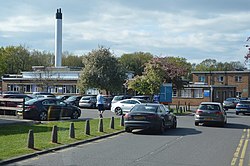History
The first hospital on the site was the No. 1 Australian Auxiliary Hospital established during the First World War to treat injured Australians and New Zealander soldiers. [2] After the war Middlesex County Council decided to use the site to build a series of single-storey pavilions which opened as the Harefield Sanatorium in October 1921. [3]
Work started on a more permanent structure in 1935 and the new building was opened on 8 October 1937 by the Duke of Gloucester, with many of the wards featuring large open areas to give patients access to the fresh air. [4] The hospital joined the National Health Service in 1948. [3]
Amongst the hospital's roll call of distinguished cardiologists were Paul Wood and Walter Somerville. Arguably, the hospital's most famous surgeon was Professor Sir Magdi Yacoub, who performed the UK's first heart and lung transplant at Harefield in 1983. [5] Under the leadership of Sir Magdi Yacoub, the Harefield Hospital transplant programme had begun in 1980 and by the end of the decade he and his team had performed one thousand of the procedures, while the hospital had become the leading UK transplant centre. [6]
In a January 2008 press release, the trust announced that Harefield Hospital had become the leader in the south east of England for treating acute heart attack patients with primary angioplasty and coronary stent insertion to reduce the length of hospital stays. [7]
In the 2010 staff survey conducted by the Care Quality Commission, one staff member in five (of those who responded to the survey [8] ) reported having been the subject of discrimination and one in fifty having been assaulted at work by a fellow staff member. However, "only a minority of staff said they felt work pressures, with four-fifths of employees adding they would recommend the trust as a place to work or receive treatment." [9]
This page is based on this
Wikipedia article Text is available under the
CC BY-SA 4.0 license; additional terms may apply.
Images, videos and audio are available under their respective licenses.


